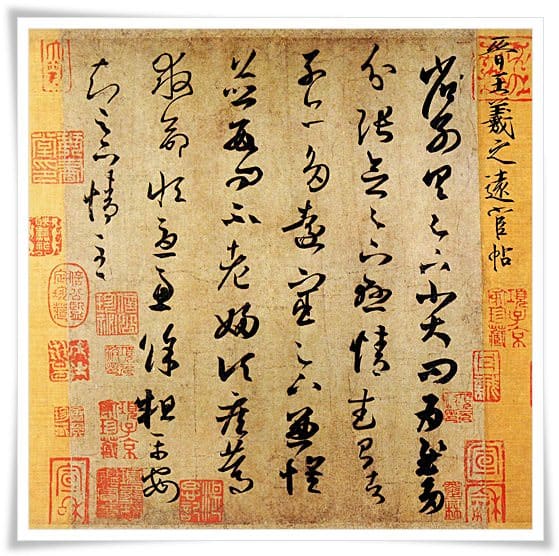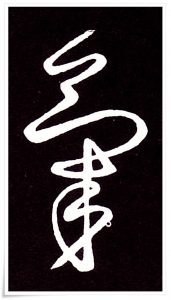“Colui la cui calligrafia poteva travolgere 10,000 uomini”, con queste parole 刘熙载 (Liú Xīzaǐ, 1813 – 1881), critico letterario e critico d’arte della dinastia Qing 清朝(1616 – 1636), descrive la potenza e l’eleganza della calligrafia di Wang Xizhi. Oggi, Wáng Xīzhī, della dinastia Jin (晉朝, 265 – 420 C.E.), è considerato il calligrafo più amato di tutti i tempi, spesso chiamato il Saggio della calligrafia (書聖; in cinese: shū shèng).
Facendo un confronto con l’occidente, Wang Xizhi rappresenta per la calligrafia cinese quello che Michelangelo è per la scultura o Shakespeare per la letteratura. Sebbene nessuna delle sue opere originali sia sopravvissuta, documenti storici confermano che Xīzhī ha creato circa 1000 capolavori. Ancora oggi i calligrafi studiano da copie delle sue opere, continuando così l’antica tradizione dell’arte calligrafica.

Wang Xizhi è nato in una famiglia nobile e potente. Suo padre aveva dei legami con la famiglia reale e alcuni membri della sua famiglia avevano il controllo militare ed esercitavano un’influenza politica sulla dinastia Jin dell’ovest. Nella storia della calligrafia, tra i cento calligrafi più famosi della dinastia Jin, venti appartenevano al clan Wáng. Molti discendenti degli Xīzhī divennero grandi calligrafi.
Fin dai suoi primi anni, Xīzhī mostrò una carattere spensierato. Inizialmente poche persone riconobbero in lui qualcosa di speciale. La mancanza di una documentazione storica approfondita rende difficile determinare in che modo Xīzhī sia maturato artisticamente; tuttavia, alcuni fatti sono noti.
Xizhi iniziò lo studio della calligrafia all’età di sette anni, inizialmente sotto la guida del padre, successivamente seguendo l’insegnamento della zia, 衛夫人 (Wèi fū ren (la Signora Wei), 272 – 349), che è stata dichiarata la migliore calligrafa donna della storia cinese. Il suo stile era elegante e potente; era un’insegnante severa e molto rigorosa. Xīzhī imparò piuttosto rapidamente le basi dello stampatello (楷書, かいしょ, kaisho) e dello stile dei funzionari (隷書, れいしょ, reisho).
All’età di nove anni Xīzhī lesse un libro scritto dalla Signora Wei intitolato “Compendio sulla battaglia del pennello” (筆陣圖, in cinese: Bǐ zhèn tú). Tre anni dopo trovò un altro libro sulle tecniche del pennello. Questo libro apparteneva a suo padre che tuttavia era piuttosto riluttante nel darglielo in quanto credeva che Xīzhī fosse ancora troppo giovane e non fosse in grado di comprenderlo correttamente. Alla fine gli permise di leggerlo. In seguito i progressi di Xīzhī nella calligrafia furono così significativi che la sua insegnante, la Signora Wei, sospettò che stesse prendendo lezioni da un altro maestro. Quel giorno la Signora Wei seppe che Xīzhī sarebbe diventato un grande calligrafo.

Si dice che la calligrafia sia “la pittura del cuore”, ovvero che rappresenti le “immagini del cuore”; che rifletta il carattere e la personalità del calligrafo, il suo vero sè. Alcuni calligrafi furono degli artisti straordinari, nonostante questo, accaddero degli eventi che rovinarono la loro reputazione. Ad esempio, un grande calligrafo della dinastia Yuan (明朝, 1368 – 1644) 趙孟頫 (Zhào Mèngfǔ, 1254 – 1322) fu considerato un collaboratore, quando, dopo aver a lungo rifiutato un posto come ministro presso la corte della dinastia mongola, finì per accettarlo.
Viceversa, in qualità di governatore di diverse prefetture, Xīzhī diede prova di essere un uomo retto ed onesto che si preoccupava del suo paese e del suo popolo. Ordinò l’apertura dei granai durante la carestia, richiese alla Corte imperiale la riduzione delle tasse e divenne noto per aver combattuto la corruzione tra i funzionari. Il suo carattere singolare e la sua natura laboriosa, unita ad un talento indiscutibile, sono le fondamenta su cui ha costruito il suo stile personale, ammirato da più di 1600 anni.

La sua calligrafia era così potente ed irresistibile che l’imperatore Taizong della Dinastia Tang (唐太宗, in cinese: Táng Tàizōng, 599 – 649) inscenò un furto della copia originale della Prefazione alle poesie composte al Padiglione delle Orchidee (蘭亭集序, in Cinese: Lántíngjí Xù), una calligrafia in stile semi-corsivo (行書, ぎょうしょ, gyōsho) di Wáng Xīzhī, scritta nel 353. L’imperatore Tàizōng fu un grandissimo ammiratore delle opere di Xīzhī, grazie a lui centinaia di rotoli originali furono copiati dai migliori calligrafi della corte imperiale. Egli promosse anche l’introduzione dello stile calligrafico di Wáng Xīzhī fra i membri della corte imperiale. L’imperatore Tàizōng ordinò che alla sua morte l’originale della Prefazione alle poesie composte al Padiglione delle Orchidee fosse sepolta con lui. Quella fu l’ultima volta in cui qualcuno poté ammirare questo capolavoro della calligrafia.
L’imperatore Tàizōng non fu l’unico sovrano ad essere affascinato dal talento di Xīzhī. L’imperatore Wu della Dinastia Liang (梁武帝, in cinese: Liáng Wǔ dì, 464 – 549 C.E.) affermò che “la calligrafia di Wáng Xīzhī è potente quanto un drago che salta attraverso la Porta del cielo o una tigre accovacciata nella torre della Fenice”. Le opere di Xīzhī furono notevolmente ammirate nella Dinastia Song da famosi calligrafi come 米黻 (Mǐ Fú, 1051 – 1107 Era corrente). Le opere di Xizhi per lui furono illuminanti e gli permisero di staccarsi dallo stile rigido della dinastia Tang, stile preferito nella sua epoca, la diastia Song (宋朝, 960 – 1279).
Calligrafi della dinastia Ming (明朝, 1368 – 1644) elogiarono la calligrafia di Xīzhī per l’eleganza, lo stile, la forma ed il sentimento, ma soprattutto per la sua grazia; sottolineando spesso che lo stile di Xīzhī era naturale, ma ricco di spirito, incantevole ma non superficiale.

Quando ammiro i capolavori di Wáng Xīzhī, non vedo semplicemente dei caratteri, piuttosto degli spiriti in movimento, vigorosi e perfettamente equilibrati; geniali creazioni di una mente ancora più retta e creativa, che mostra visivamente tutte le relazioni complesse e armoniose che ne esistono. Le sue opere, sebbene siano soltanto copie degli originali, sono semplicemente incantevoli.
Wáng Xīzhī condusse una vita movimentata, il suo carattere fuori dal comune è ricordato da numerosi aneddoti divertenti che portano nomi bizzarri come “il divano dell’est” e “penetrare tre millimetri nel legno.” La sua passione per le oche ha influenzato il suo stile calligrafico, un’altra storia interessante da raccontare. La seconda parte di questo articolo affronterà molti di questi argomenti.
Esistono molte copie dei capolavori di Wáng Xīzhī, molte sono particolarmente straordinarie. Seguiranno articoli separati su ciascuno di questi argomenti.
